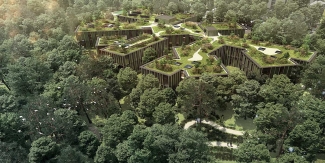New EFI policy brief explores how trees and urban forests combat health problems

By 2050, over 70% of the world’s population will live in cities. 200 years of unprecedented urbanization and economic growth based on a fossil-based economy have rapidly transformed our societies, posing urgent challenges related to climate change, biodiversity loss and environmental degradation, all major threats to human health. Urban lifestyles, characterised by chronic stress, social isolation, and lack of physical activity, have changed the global disease burden, which is now dominated by non-communicable diseases (NCDs), such as obesity, heart diseases, diabetes, and depression.
Urban trees are a multifaceted solution to several challenges, and more and more new research shows the impressive positive impacts trees, forests, wood and green spaces have on human wellbeing. EFI’s latest Policy Brief “Combating health problems with urban forests” explains how by prioritizing the integration of trees into urban planning and policy, cities can create healthier, more resilient, and sustainable urban environments for current and future generations.
“The global and urgent challenges posed by urbanization can partly be addressed by nature-based solutions, such as urban forests and green areas, which have the potential to improve both the city environment and human health. In fact, they mitigate the effects of climate change and promote public health and well-being, something policymakers should pay close attention to– we need to transform our cities into Biocities that promote life, biodiversity and health”, says author Matilda van den Bosch, senior researcher at EFI’s Biocities Facility.
The Policy Brief builds on a vast amount of research studies demonstrating that living in urban green neighbourhoods promotes physical activity and social interactions between people with profound benefits for public health and healthcare savings. The promotion of healthy behaviours significantly reduces the number of NCDs and makes people live longer and healthier lives.
Biodiverse environments lead to improved immune function: contact with biodiverse environments improves children’s immune systems, potentially reducing the prevalence of a number of “modern” illnesses, such as allergies and asthma. Urban forests contribute to biodiversity by providing habitats for diverse plant and animal species.
Urban forests also respond to citizens' recreational demands while also mitigating part of large cities’ carbon debt. An important climate adaptation impact is the cooling of urban temperatures, which directly prevents heat-related illnesses in cities and saves tens of thousands of lives each year.
The policy brief sets out 4 recommendations for policymakers, including multi-sectorial collaborations, incorporating trees in urban planning, conducting health assessments to quantify benefits and healthcare savings from green infrastructures, and educating and engaging communities on the benefits of urban trees.
Read the Policy Brief at https://doi.org/10.36333/pb9
Van den Bosch M. Combating health problems with urban forests. Policy Brief 9. European Forest Institute. https://doi.org/10.36333/pb9


